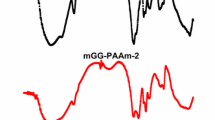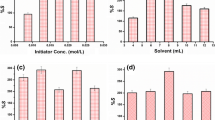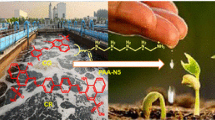Abstract
A semi-interpenetrating network consisting of karaya gum-graft-polyacrylamide and poly(vinyl alcohol) has been developed as an adsorbent material for dye removal applications. The system was made by microwave irradiation of the aqueous mixture of karaya gum, acrylamide, N,N′-methylenebisacrylamide, and poly (vinyl alcohol); and was characterized by FTIR, TGA, SEM, and XRD techniques. It was evaluated as an adsorbent material for removal of ionic dyes from aqueous solutions. Appreciably high adsorption capacity is exhibited by the material towards cationic dyes as indicated by values of maximum adsorption capacity of 82.28, 72.94, 48.75 and 34.67 mg/g towards adsorption of cationic dyes, namely methylene blue (MB), crystal violet (CV), rhodamine B (Rh B), and toluidine blue (TB). Relatively low value of 21.66 mg/g is obtained for anionic dye indigo carmine (IC). The kinetic data of dye adsorption best fitted with the pseudo-first-order kinetic model with R2 values of 0.979, 0.989, 0.946, 0.991, and 0.986 for TB, MB, CV, Rh B and IC, respectively. The isotherm data fit well with the Freundlich model with R2 values of 0.986, 0.955, 0.990, 0.980 and 0.993 for TB, MB, CV, Rh B, and IC, respectively, indicating the heterogeneous and multilayer adsorption. The thermodynamic studies showed dye adsorption to be an exothermic and spontaneous process.












Similar content being viewed by others
Abbreviations
- APS:
-
Ammonium persulfate
- CV:
-
Crystal violet
- FTIR:
-
Fourier transform infrared spectroscopy
- IC:
-
Indigo carmine
- IPN:
-
Interpenetrating network
- KG:
-
Karaya gum
- (KG-g-PAAm)–PVA:
-
(Karaya gum-graft-polyacrylamide)–poly (vinyl alcohol)
- MB:
-
Methylene blue
- MBA:
-
N,N’-Methylenebisacrylamide
- PAAm:
-
Polyacrylamide
- PVA:
-
Poly (vinyl alcohol)
- Rh B:
-
Rhodamine B
- SEM:
-
Scanning electron microscopy
- TB:
-
Toluidine blue
- TGA:
-
Thermogravimetric analysis
- XRD:
-
X-ray diffraction
References
Petersen L, Heynen M, Pellicciotti F (2016) Freshwater resources: past, present, future. International encyclopedia of geography: people, the earth, environment and technology. Wiley-Blackwell, London. https://doi.org/10.1002/9781118786352.wbieg0712
Nazir MA, Yasar A, Bashir MA, Siyal SH, Najam T, Javed MS, Ahmad K, Hussain S, Anjum S, Hussain E, Shah SSA, Rehman A (2020) Quality assessment of the noncarbonated-bottled drinking water: comparison of their treatment techniques. Int J Environ Anal Chem 100:1–12. https://doi.org/10.1080/03067319.2020.1846732
Ayub A, Irfan A, Raza ZA, Abbas M, Muhammad A, Ahmad K, Munwar A (2021) Development of poly(1-vinylimidazole)-chitosan composite sorbent under microwave irradiation for enhanced uptake of Cd (II) ions from aqueous media. Polym Bull 159:1–21. https://doi.org/10.1007/s00289-020-03523-7
Naseem HA, Aziz T, Shah H, Ahmad K, Parveen S, Ashfaq M (2020) Rational synthesis and characterization of medicinal phenyl diazenyl-3-hydroxy-1H-inden-1-one azo derivatives and their metal complexes. J Mol Struct 1227:129574. https://doi.org/10.1016/j.molstruc.2020.129574
Shah H, Ahmad K, Naseem HA, Parveen S, Ashfaq M, Rauf A, Aziz T (2021) Water stable graphene oxide metal-organic frameworks composite (ZIF-67@GO) for efficient removal of malachite green from water. Food Chem Toxicol 154:112312. https://doi.org/10.1016/j.fct.2021.112312
Ahmad K, Shah H, Parveen S, Aziz T, Naseem HA, Ashfaq M, Rauf A (2021) Metal organic framework (KIUB-MOF-1) as efficient adsorbent for cationic and anionic dyes from brackish water. J Mol Struct 1242:130898. https://doi.org/10.1016/j.molstruc.2021.130898
Ahmad K, Shah H, Nasim HA, Ayub A, Ashfaq M, Rauf A, Shah SSA, Ahmad MM, Nawaz H, Hussain E (2021) Synthesis and characterization of water stable polymeric metallo organic composite (PMOC) for the removal of arsenic and lead from brackish water. Toxin Rev. https://doi.org/10.1080/15569543.2021.1919902
Ghaly A, Ananthashankar R, Alhattab M, Ramakrishnan V (2014) Production, characterization, and treatment of textile effluents: a critical review. J Chem Eng Process Technol 5:1–18
Moussavi G, Mahmoudi M (2009) Removal of azo and anthraquinone reactive dyes from industrial wastewaters using MgO nanoparticles. J Hazard Mater 168:806–812. https://doi.org/10.1016/j.jhazmat.2009.02.097
Liu RR, Tian Q, Yang B, Chen J (2010) Hybrid anaerobic baffled reactor for treatment of desizing wastewater. Int J Environ Sci Technol 7:111–118. https://doi.org/10.1007/BF03326122
Yaseen D, Scholz M (2019) Textile dye wastewater characteristics and constituents of synthetic effluents: a critical review. Int J Environ Sci Technol 16:1193–1226. https://doi.org/10.1007/s13762-018-2130-z
Al-Momani F, Touraud E, Degorce-Dumas JR, Roussy J, Thomas O (2002) Biodegradability enhancement of textile dyes and textile wastewater by VUV photolysis. J Photochem Photobiol A: Chem 153:191–197
Samsami S, Mohamadi M, Sarrafzadeha M, Rene ER, Firoozbahr M (2020) Recent advances in the treatment of dye-containing wastewater from textile industries: overview and perspectives. Process Saf Environ 143:138–163. https://doi.org/10.1016/j.psep.2020.05.034
Bhattacharyya R, Ray SK (2015) Adsorption of industrial dyes by semi-IPN hydrogels of acrylic copolymers and sodium alginate. J Ind Eng Chem 22:92–102. https://doi.org/10.1016/j.jiec.2014.06.029
Mittal H, Babu R, Dabbawala AA, Stephen S, Alhassan SM (2020) Zeolite-Y incorporated karaya gum hydrogel composites for highly effective removal of cationic dyes. Colloids Surf A: Physicochem Eng Asp 586:124161. https://doi.org/10.1016/j.colsurfa.2019.124161
Mittal H, Babu R, Alhassan SM (2020) Utilization of gum xanthan based superporous hydrogels for the effective removal of methyl violet from aqueous solution. Int J Biol Macromol 143:413–423. https://doi.org/10.1016/j.ijbiomac.2019.11.008
Uzum OB, Karadag E (2011) Dye sorption and water uptake properties of crosslinked acrylamide/sodium methacrylate copolymers and semi-interpenetrating polymer networks composed of PEG. Sep Sci Technol 46:489–499. https://doi.org/10.1080/01496395.2010.513697
Arun Krishna K, Vishalakshi B (2017) Gellan gum-based novel composite hydrogel: evaluation as adsorbent for cationic dyes. J Appl Polym Sci 134:45527–45534. https://doi.org/10.1002/app.45527
Mittal H, Alhassan SM, Ray SS (2018) Efficient organic dye removal from wastewater by magnetic carbonaceous adsorbent prepared from corn starch. J Environ Chem Eng 6:7119–7131. https://doi.org/10.1016/j.jece.2018.11.010
Kumar V, Rehani V, Singh B, Kaith S (2018) Synthesis of a biodegradable interpenetrating polymer network of Av-cl-poly(AA-ipn-AAm) for malachite green dye removal: kinetics and thermodynamic studies. RSC Adv 8:41920–41937. https://doi.org/10.1039/C8RA07759B
Bhattacharyya R, Ray SK (2014) Enhanced adsorption of synthetic dyes from aqueous solution by a semi-interpenetrating network hydrogel based on starch. J Ind Eng Chem 20:3714–3725. https://doi.org/10.1016/j.jiec.2013.12.071
Jeon YS, Lei J, Kim J (2008) Dye adsorption characteristics of alginate/polyaspartate hydrogels. J Ind Eng Chem 14:726–731. https://doi.org/10.1016/J.JIEC.2008.07.007
Singh B, Sharma N (2009) Mechanistic implication for cross-linking in sterculia-based hydrogels and their use in GIT drug delivery. Biomacromol 10:2515–2532. https://doi.org/10.1021/bm9004645
Padil VVT, Nguyen NHA, AlenaŠevcR HM (2015) Fabrication, characterization, and antibacterial properties of electrospun membrane composed of gum karaya, polyvinyl alcohol, and silver nanoparticles. J Nanomater 2015:1–10. https://doi.org/10.1155/2015/750726
Baker MI, Walsh SP, Schwartz Z, Boylan BD (2012) A review of polyvinyl alcohol and its uses in cartilage and orthopedic applications. J Biomed Mater Res Part B Appl Biomater 100B:1451–1457. https://doi.org/10.1002/jbm.b.32694
Krishnappa PB, Badalamoole V (2019) Karaya gum-graft-poly(2-(dimethylamino) ethyl methacrylate) gel: an efficient adsorbent for removal of ionic dyes from water. Int J Biol Macromol 122:997–1007. https://doi.org/10.1016/j.ijbiomac.2018.09.038
Siddaiaha T, Ojhaa P, Kumara NOGV, Ramu C (2018) Structural, optical, and thermal characterizations of PVA/MAA: EA polyblend films. Mater Res 21:987–998. https://doi.org/10.1590/1980-5373-MR-2017-0987
Hemvichian K, Chanthawong A, Suwanmala P (2014) Synthesis and characterization of superabsorbent polymer prepared by radiation-induced graft copolymerization of acrylamide onto carboxymethyl cellulose for controlled release of agrochemicals. Radiat Phys Chem 103:167–171. https://doi.org/10.1016/j.radphyschem.2014.05.064
Sethi S, Kaith BS, Kaur M, Sharma N, Khullar S (2019) Study of a cross-linked hydrogel of karaya gum and starch as a controlled drug delivery system. J Biomater Sci- Polym Ed 30:1687–1708. https://doi.org/10.1080/09205063.2019.1659710
Pique TM, Pe’rez CJ, Alvarez VA, Va’zquez A (2014) Water soluble nanocomposite films based on poly(vinyl alcohol) and chemically modified montmorillonites. J Compos Mater 48:545–553. https://doi.org/10.1177/0021998313476322
Liu D, Li J, Sun F, Xiao R, Guo Y, Song J (2014) Liquid crystal microphase separation of cellulose nanocrystals in wet-spun PVA composite fibres. RSC Adv 4:30784–30789. https://doi.org/10.1039/C4RA04063E
Aziz SB, Abdulwahid RT, Rasheed MA, Abdullah OG, Ahmed HM (2017) Polymer blending as a novel approach for tuning the SPR peaks of silver nanoparticles. Polymers 9:486–498. https://doi.org/10.3390/polym9100486
Briscoe B, Luckham P, Zhu S (2000) The effects of hydrogen bonding upon the viscosity of aqueous poly(vinyl alcohol) solutions. Polymer 41:3851–3860. https://doi.org/10.1016/S0032-3861(99)00550-9
Singh S, Srivastava SK, Singh DK (2014) Hydrogen bonding patterns in different acrylamide–water clusters: micro solvation probed by micro-Raman spectroscopy and DFT calculations. RSC Adv 4:1761–1774. https://doi.org/10.1039/C3RA42707B
Schott H (1992) Swelling kinetics of polymers. J Macromol Sci B 31:1–9
Ritger PL, Peppas NA (1987) A simple equation for description of solute release I. Fickian and non-fickian release from non-swellable devices in the form of slabs, spheres, cylinders, or discs. J Control Release 5:23–36. https://doi.org/10.1016/0168-3659(87)90034-4
Karadag E, Kundakci S (2013) Water and dye uptake studies of acrylamide/4-styrenesulfonic acid sodium salt copolymers and semi-interpenetrating polymer networks composed of gelatin and/or PVA. Adv Polym Technol 32:531–544
Dixit A, Bag DS, Kalra SJS (2017) Synthesis of strong and stretchable double network (DN) hydrogels of PVA-borax and P(AM-co-HEMA) and study of their swelling kinetics and mechanical properties. Polymer 119:263–273. https://doi.org/10.1016/j.polymer.2017.05.002
Kulal P, Krishnappa PB, Badalamoole V (2021) Development of gum acacia based magnetic nanocomposite adsorbent for wastewater treatment. Polym Bull 154:1–16. https://doi.org/10.1007/s00289-021-03909-1
Klaus H (2003) Industrial dyes: chemistry, properties, applications. Wiley, Germany
Fang Y, Zhou A, Yang W, Araya T, Huang Y, Zhao P, Johnson D, Wang J, Ren ZJ (2018) Complex Formation via hydrogen bonding between rhodamine B and montmorillonite in aqueous solution. Sci 8:229–239
Sandeman SR, Gun’ko VM, Bakalinska OM, Howell CA, Zheng Y, Kartel MT, Phillips GJ, Mikhalovsky SV (2011) Desorption of anionic and cationic dyes by activated carbons, PVA hydrogels, and PVA/AC composite. J Colloid Interface Sci 358:582–592. https://doi.org/10.1016/j.jcis.2011.02.031
Ghorai S, Sarkar A, Raoufi M, Panda AB, Schonherr H, Pal S (2014) Enhanced removal of methylene blue and methyl violet dyes from aqueous solution using a nanocomposite of hydrolyzed polyacrylamide grafted xanthan gum and incorporated nanosilica. ACS Appl Mater Interfaces 6:4766–4777. https://doi.org/10.1021/am4055657
Sharma G, Kumar A, Naushad M, García-Peñas A, AlMuhtaseb AH, Ghfar AA, Sharma V, Ahamad T, Stadler FJ (2018) Fabrication and characterization of Gum arabic-cl-poly(acrylamide) nanohydrogel for effective adsorption of crystal violet dye. Carbohyd Polym 202:444–453. https://doi.org/10.1016/j.carbpol.2018.09.004
Deng JH, Luo J, Mao YL, Lai S, Gong YN, Zhong DC, Lu TB (2020) π-π stacking interactions: non-negligible forces for stabilizing porous supramolecular frameworks. Sci Adv 6:1–12. https://doi.org/10.1126/sciadv.aax9976
Rápó E, Tonk S (2021) Factors affecting synthetic dye adsorption; desorption studies: a review of results from the last five years (2017–2021). Molecules 26:5419. https://doi.org/10.3390/molecules26175419
Lagergren S (1898) About the theory of so-called adsorption of soluble substances. Handlingar 24:1–39
Ho YS, McKay G (1999) Pseudo-second order model for sorption processes. Process Biochem 34:451–465. https://doi.org/10.1016/S0032-9592(98)00112-5
Freundlich H (1926) Colloid and capillary chemistry. J Soc Chem Ind 45:797–798. https://doi.org/10.1002/jctb.5000454407
Ayawei N, Ebelegi AN, Wankasi D (2017) Modelling and interpretation of adsorption isotherms. J Chem 2017:1–11. https://doi.org/10.1155/2017/303981
Tempkin MI, Pyzhev V (1940) Kinetics of ammonia synthesis on promoted iron catalyst. Acta Phys Chem 12:327–356
Patel YN, Patel MP (2012) Novel cationic poly [AAm/NVP/DAPB] hydrogels for removal of some textile anionic dyes from aqueous solution. J Macromol Sci A 49:490–501. https://doi.org/10.1080/10601325.2012.676915
Hall KR, Eagleton LC, Acrivos A, Vermeulen T (1966) Pore- and solid-diffusion kinetics in fixed-bed adsorption under constant-pattern conditions. Ind Eng Chem Fundam 5:212–223. https://doi.org/10.1021/i160018a011
Ashraf MW, Abulibdeh N, Salam A (2019) Adsorption studies of textile dye (chrysoidine) from aqueous solutions using activated sawdust. Int J Chem Eng 2019:1–8. https://doi.org/10.1155/2019/9728156
Abramian L, El-Rassy H (2009) Adsorption kinetics and thermodynamics of azo-dye orange II onto highly porous titania aerogel. Chem Eng J 150:403–410. https://doi.org/10.1016/j.cej.2009.01.019
Mittal H, Ray SS (2016) A study on the adsorption of methylene blue onto gum ghatti/TiO2 nanoparticles-based hydrogel nanocomposite. Int J Biol Macromol 88:66–80. https://doi.org/10.1016/j.ijbiomac.2016.03.032
Mittal H, Alili AA, Alhassan SM (2020) High efficiency removal of methylene blue dye using k-carrageenan-poly(acrylamide-co-methacrylic acid)/ AQSOA-Z05 zeolite hydrogel composites. Cellulose 27:8269–8285. https://doi.org/10.1007/s10570-020-03365-6
Feira JMC, Klein JM, Forte MMC (2018) Ultrasound-assisted synthesis of polyacrylamide-grafted sodium alginate and its application in dye removal. Polímeros 28:139–146. https://doi.org/10.1590/0104-1428.11316
Lafi R, Rezma S, Hafiane A (2014) Removal of toluidine blue from aqueous solution using orange peel waste (OPW). Desalin Water Treat 56:2754–2765. https://doi.org/10.1080/19443994.2014.982962
Patel H, Vashi RT (2010) A study on removal of toluidine blue from aqueous solution by adsorption on to neem leaf powder. Int J Chem Mol Eng 4:674–680. https://doi.org/10.5281/zenodo.1057881
Bretanha MS, Dotto GL, Vaghetti JCP, Dias SLP, Lima EC, Pavan FA (2016) Giombo persimmon seed (GPS) an alternative adsorbent for the removal toluidine blue dye from aqueous solutions. Desalin Water Treat 57(58):28474–32848
Guo L, Li G, Liu J, Ma S, Zhang J (2011) Kinetic and equilibrium studies on adsorptive removal of toluidine blue by water-insoluble starch sulphate. J Chem Eng Data 56:1875–1881. https://doi.org/10.1021/je100891b|
Mittal H, Maity A, Ray SS (2016) Gum karaya based hydrogel nanocomposites for the effective removal of cationic dyes from aqueous solutions. Appl Surf Sci 364:917–930. https://doi.org/10.1016/j.apsusc.2015.12.241
Mittal H, Kumar V, Alhassan SM, Ray SS (2018) Modification of gum ghatti via grafting with acrylamide and analysis of its flocculation, adsorption, and biodegradation properties. Int J Biol Macromol 114:283–294. https://doi.org/10.1016/j.ijbiomac.2018.03.131
Hayeeye F, Sattar M, Chinpa W, Sirichote O (2017) Kinetics and thermodynamics of rhodamine B adsorption by gelatin/activated carbon composite beads. Colloids Surf A: Physicochem Eng Asp 513:259–266. https://doi.org/10.1016/j.colsurfa.2016.10.052
Al-Mubaddel FS, Haider S, Aijaz MO, Haider A, Kamal T, Almasry WA, Javid M, Khan SU (2017) Preparation of the chitosan/polyacrylonitrile semi-IPN hydrogel via glutaraldehyde vapours for the removal of rhodamine B dye. Polym Bull 74:1535–1551. https://doi.org/10.1007/s00289-016-1788-y
Mittal H, Alili A, Morajkar PP, Alhassan SM (2021) Graphene oxide crosslinked hydrogel nanocomposites of xanthan gum for the adsorption of crystal violet dye. J Mol Liq 323:115034. https://doi.org/10.1016/j.molliq.2020.115034
Mahdavinia GR, Aghaie H, Sheykhloie H, Vardini MT, Etemadi H (2013) Synthesis of CarAlg/MMt nanocomposite hydrogels and adsorption of cationic crystal violet. Carbohydr Polym 98:358–365. https://doi.org/10.1016/j.carbpol.2013.05.096
Pourjavadi A, Hosseini SH, Seidi F, Soleyman R (2013) Magnetic removal of crystal violet from aqueous solutions using polysaccharide-based magnetic nanocomposite hydrogels. Polym Int 62:1038–1044. https://doi.org/10.1002/pi.4389
Fatombi JK, Idohou EA, Osseni SA, Agani I, Neumeyer D, Verelst M, Mauricot R, Aminou T (2019) Adsorption of indigo carmine from aqueous solution by chitosan and chitosan/activated carbon composite: kinetics, isotherms, and thermodynamics studies. Fibers Polym 20:1820–1832. https://doi.org/10.1007/s12221-019-1107-y
Preetha BK, Badalamoole V (2019) Modification of karaya gum by graft copolymerization for effective removal of anionic dyes. Sep Sci Technol 54:2638–2652. https://doi.org/10.1080/01496395.2018.1549079
Gopi S, Balakrishnan P, Pius A, Thomas S (2017) Chitin nanowhisker (ChNW)-functionalized electrospun PVDF membrane for enhanced removal of indigo carmine. Carbohydr Polym 165:115–122. https://doi.org/10.1016/j.carbpol.2017.02.046
Zauro SA, Badalamoole V (2017) Synthesis of locust bean gum-based terpolymer bentonite composite: evaluation for indigo carmine adsorption. Int J Adv Chem 5:61–69. https://doi.org/10.14419/ijac.v5i2.7930
Author information
Authors and Affiliations
Corresponding author
Additional information
Publisher's Note
Springer Nature remains neutral with regard to jurisdictional claims in published maps and institutional affiliations.
Rights and permissions
About this article
Cite this article
Krishnappa, P.B., Kodoth, A.K., Kulal, P. et al. Effective removal of ionic dyes from aqueous media using modified karaya gum–PVA semi-interpenetrating network system. Polym. Bull. 80, 2553–2584 (2023). https://doi.org/10.1007/s00289-022-04169-3
Received:
Revised:
Accepted:
Published:
Issue Date:
DOI: https://doi.org/10.1007/s00289-022-04169-3




